For nearly 20 years, Tennessee-based Mike Jones Aircraft has been cranking out Lock & Key Piper Navajos. This is an extensive teardown-refurbishment process that makes the airplane better than new, thanks to a variety of STC’d mods (the company bought the aftermarket performance mod company Colemill roughly 13 years ago) and a slew of modern improvements.
But Jones (and potential customers) have been wanting to expand the Lock & Key refurbishment program to other models and that’s exactly what he’s done with the Lock & Key Beech Baron. Like the Navajo program, the Lock & Key Baron I looked at for this report certainly follows company tradition in turning out a finished product that’s a showpiece, backed up with solid gains in performance and capability compared to the original airplane.
BRING YOUR OWN PLANE
Unlike previous Navajo refurbishments where the company sources the airplanes and refurbishes them, Jones is changing it up and is focusing on refurbing existing customer aircraft. He made it clear that the Lock & Key program isn’t limited to Piper Navajos or Beech Barons. With an aging fleet, there are plenty of aircraft that deserve a new lease on life, and Jones says there are plenty of buyers willing to pay the price premium (and deal with the long downtime) it takes to do the refurbishment.
The Baron B58 in this report is a 2007 model that a customer bought to refurbish (he actually wanted a Navajo but his insurer wouldn’t write a policy for one because of his age) and after nearly a year of downtime, it’s definitely a better airplane. Part of that is because the Lock & Key program puts a sharp focus on getting the airplane up to an extremely high maintenance standard. Jones admitted that customers are usually surprised at all the maintenance items that are outstanding once the airplane hits his shop floor. While there might be some flexibility in the level of teardown-rebuild of some systems, commit to the Lock & Key program and get ready to address pages and pages of maintenance squawks. There’s far more to the refurb program than nice paint and new avionics, although these are certainly high on the hit list of work to be accomplished. And it’s a lot of work.
LOADED WITH MODS
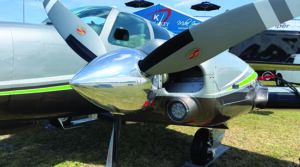
The Baron really benefits from the Lock & Key process because Jones owns nearly all of the major STCs that Colemill developed, including engine power and winglet mods. This later-model B58 already came with 300-HP Continental IO-550 engines, but the project included installation of Hartzell three-blade scimitar propellers. Older Barons (prior to 1983) with smaller IO-520 engines can get the 300-HP engines, by way of STC.
Some people wonder why a Baron needs winglets, but there are some gains in performance. The basic purpose of winglets is to reduce lift-induced drag by breaking up wingtip vortices. But that primary function sets off a chain reaction of other favorable characteristics. The winglets reduce yaw—especially in turbulence. During stalls, they prevent the wingtip from stalling first, thus reducing the tendency of one wing dropping before the other.
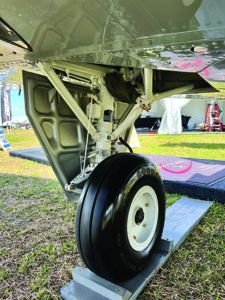
They also result in shorter takeoff runs, a shorter landing rollout, better climb rates, better single-engine handling and improved aileron response. Jones said they might increase cruise speed a touch—plan on 200 knots true. The Baron also gets VGs, which help even more with low-speed handling and slower stall speeds.
The winglets mod also includes long-range fuel tanks (15 additional gallons per side), giving the Baron longer legs (200 more miles) for traveling. The tanks have separate filler caps and replace the Baron’s outboard wing panel. You really don’t have to do anything different to manage the fuel— it’s moved by transfer pumps into the main tanks and automatically shuts off when the tanks are empty.
Worth mentioning is that as light twins go, all of the Baron 58s have comparatively good payload with full fuel. A typically equipped older 58, with auxiliary fuel giving a total of 166 gallons usable, can lift 724.5 pounds and fly for approximately 5.5 hours at an intermediate power setting—a still-air range of just over 1000 NM—with IFR reserves. With all the mods, it’s even better with a Lock & Key.
I was surprised at how much bigger the Lock & Key appeared compared to a stock B58 and that’s because of the winglet mod. Overall, the wingspan with the extended fuel tanks and winglets installed is just shy of 40 feet. Keep that in mind for smaller hangars.
The B58 originally came with factory air conditioning, but the refurbishment process includes an overhaul that makes it blow nice and cold. And the cabin of a Lock & Key is a comfy and first-class dwelling. All of the work is done in-house and everything is stripped from the airframe.
The refurb includes new carpeting, side panels, headliner, tray table and a bunch of convenience options, including plug-ins for Bose headsets at every station. The Baron I looked at had carbon fiber trim and cabinetry that would have been at home in the highest-end bizjet.
The same can be said for the paint work. The Lock & Key mod is notorious for sporting the industry’s best, and the custom paint job on this Baron was spectacular, as you would expect for the price. And of course, customers get to plan their own paint scheme.
AVIONICS UPGRADE
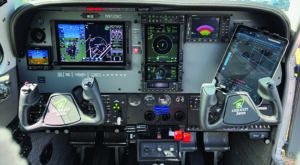
This Baron originally came with a suite of BendixKing avionics, and everything was removed (with the exception of the BendixKing KMD display that overlays the weather radar). Even though this later-model Baron had the modern instrument panel, the Lock & Key mod includes a new one that’s custom cut and finished in-house.
The aircraft I saw had the latest Garmin gear, including the G600 TXi primary flight display with EIS engine display, GTN 750 and GTN 650 IFR navigators, a Garmin audio system, ADS-B In and Out and a Garmin G5 electronic flight instrument for backup. But the real utility in the suite comes in the Garmin GFC 600 autopilot/flight control system.
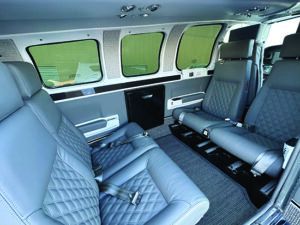
This GFC autopilot has Garmin’s Smart Rudder Bias electronic stability system for Vmc rollover protection. It’s really another layer in Garmin’s Autonomi suite of safety backstops and in the Baron, it can really be a lifesaver.
Garmin’s Smart Rudder Bias is enabled on takeoff as the aircraft reaches Vmc. It remains active throughout the flight and is designed to quickly recognize the loss of power on one engine and to immediately apply corrective rudder to overcome some of the yaw.
Smart Rudder Bias is actually software that works cooperatively between the G500/G600 TXi EFIS with the engine indication system (EIS) and the GFC 600 autopilot with yaw damper.
It really is smart because the engine failure is recognized using data available within the EIS that indicate more than a 30 percent power differential with accompanying yaw.
Once recognized, the failure is announced on the EFIS, and the autopilot applies corrective rudder. The GFC 600 autopilot includes a system Garmin calls Electronic Stability and Protection, ESP.
While Barons are generally considered good instrument platforms, and the 58s the best of the group, workload is relatively high because of the responsiveness. They have light control pressures and are highly responsive, but there’s a slight price to pay in turbulence when in IMC, but that’s tamed by Garmin’s good-working autopilot.
This system is always operating (it can be disabled) and monitors pitch, roll and airspeed parameters. When activated, SRB tightens the parameters and guards more tightly against low airspeed. We flew Garmin’s Smart Rudder Bias for a report in the December 2021 issue of Aviation Consumer.
THE LITTLE THINGS
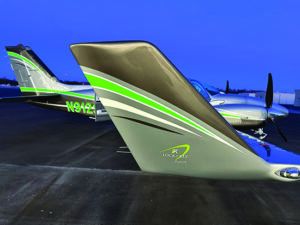
Over the years, Jones would say that his refurbishment process addresses every system down to the last light bulb and that’s actually true. As one example, the circuit breaker panel is reworked and includes LED backlighting that’s far better than the one that came standard from the factory. In addition to the new instrument panel, the rework also includes refurbishing the subpanel.
And on the outside, the aircraft gets LED lighting all around, of course.
CHANGING TIMES
“In days gone by, we would purchase the aircraft (mainly the Navajos), perform the Lock & Key refurbishment and then sell the aircraft after it’s been reworked. But now we encourage owners to bring in their own aircraft for an evaluation,” Jones told me. Part of what he was getting at is not every aircraft may be a good candidate for a Lock & Key project. I think you really want to start with a lower-time airframe that has already been we’ll maintained, although when the company is done with it might not have been as well-maintained as you thought it was.

The other thing you need to accept is that a Lock & Key refurbishment means a lot of shop time and that means living without the airplane for a long time. The Baron featured here was down for a lot longer than it probably should have been because Jones dealt with delays in sourcing the engines from Continental. In the current engine market, that’s just the way it is. But even so, a Lock & Key project might be down for almost a year.
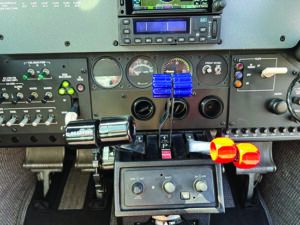
Part of that is because the refurbishment team doesn’t finish the job and hand the airplane over. Jones has done enough Lock & Key Navajos to know there will inevitably be bugs to work out, and when you’re forking over this kind of money you certainly expect a squawk-free airplane.
To work the bugs out, Jones personally flies the aircraft for as much as 30 hours—and that takes time.
As for price, the bottom line depends on how much you already have invested in the airplane, of course. The owner of this Baron B58 paid roughly $325,000 for the aircraft, and after the Lock & Key refurbishment was into it for just shy of $1.2 million. And yes, there are some newer Baron G58s on the market, which are priced in that ballpark. New ones are priced even higher. But part of the appeal (other than the aftermarket performance mods) is the customization program— where you can essentially spec your own plane.
As for support, Jones has invested big in a new 20,000-square-foot facility in Murfreesboro, Tennessee, which is proof he’s certainly committed to Lock & Key projects moving forward, as he has been for over 20 years. Plus, he’s committed to doing Lock & Key refurbs on a wide variety of airplane models—twins and singles.
Based on the refurb projects I’ve seen, for those willing to invest the time and money, they’re rewarded with an airplane that will sit at the very top of the food chain. See more mods and refurbs at www.mikejonesaircraft.com, or visit the shop at Murfreesboro Airport in Tennessee.
 See a video on the Lock & Key Baron refurb at
See a video on the Lock & Key Baron refurb at
http://tinyurl.com/j95ht2a.





